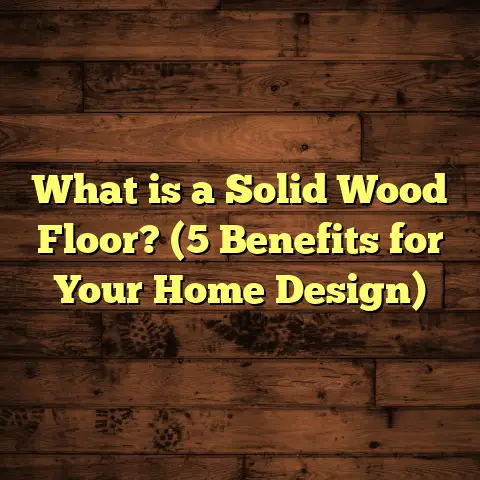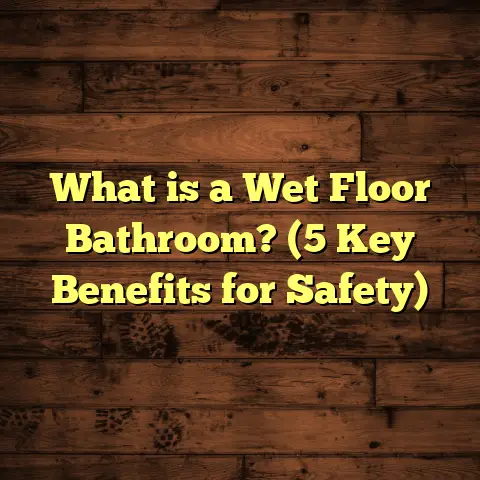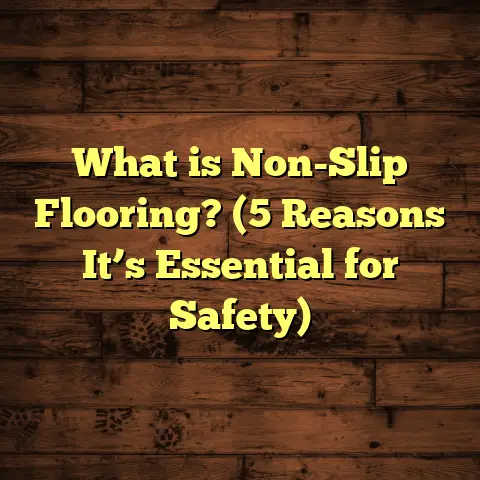What is a Printed Wood Floor? (5 Benefits for Your Home Style)
The flooring industry has been buzzing with new ideas and innovations, and one trend that’s really caught my attention is printed wood flooring. It’s been popping up in homes and showrooms alike, and I have to say, it’s pretty exciting. If you’re like me, always on the lookout for ways to blend style with practicality, printed wood floors might just be the answer you’ve been curious about. So, what exactly are these floors, and why are they gaining popularity? Let me walk you through everything I’ve learned, along with some personal experiences and useful insights.
What Is a Printed Wood Floor?
So, what is a printed wood floor? Simply put, it’s a type of flooring where the wood grain patterns and textures are created through a high-resolution printing process rather than being naturally cut from solid wood. Imagine taking a photograph of real wood—its knots, grains, and imperfections—and then printing that image onto another material, often laminate or vinyl. This gives you the classic look of wood without all the typical drawbacks.
Now, you might be wondering, isn’t this just laminate or vinyl flooring? Yes and no. Printed wood floors fall under the umbrella of these materials but stand out because of how advanced the printing technology has become. The patterns are incredibly detailed and realistic, sometimes even fooling the most discerning eye.
From my experience installing these floors for clients, I can say that the quality has come a long way. Early versions were flat and dull, but now, with embossing techniques that mimic the texture of real wood, they feel authentic too.
How Printed Wood Floors Are Made
Understanding the manufacturing process sheds light on why printed wood floors look so good today. The core idea is digital printing technology combined with surface embossing. Here’s how it works:
- High-Resolution Scanning: Manufacturers start by capturing images of real hardwood planks using high-quality scanners or cameras. These images include every detail—the grain patterns, knots, color variations, even small defects.
- Digital Printing: Using advanced printers, these images are then transferred onto a substrate layer—usually a thin sheet of paper or film—in large rolls.
- Lamination: This printed sheet is bonded to the core layer (like HDF or vinyl) using heat and pressure.
- Embossing: To add texture, an embossing machine presses patterns into the surface that correspond exactly to the printed grain. This step makes the floor feel like real wood underfoot.
- Wear Layer Application: A transparent protective coating is added on top to guard against scratches, stains, and UV fading.
This process means manufacturers can produce floors with consistent quality and design variety at scale.
Printed Wood vs Real Wood: What’s Different?
You might ask how printed wood floors compare with natural hardwood beyond appearance. Here’s a quick comparison based on my observations and research:
| Feature | Printed Wood Floor | Real Wood Floor |
|---|---|---|
| Appearance | Highly realistic printed grain | Natural grain varies plank to plank |
| Texture | Embossed to mimic wood texture | Natural texture varies |
| Cost | 30-50% less expensive | Usually more costly |
| Durability | Scratch & moisture resistant | Can dent and scratch easily |
| Installation | Easier with click-lock systems | Requires nails/glue & expertise |
| Maintenance | Easy cleaning; no refinishing | Needs sanding & refinishing over time |
| Water Resistance | Some types waterproof | Vulnerable to moisture damage |
| Environmental Impact | Uses less timber overall | Uses natural timber |
This table helps explain why many homeowners are switching to printed wood floors as a smarter alternative for everyday living spaces.
Why Printed Wood Floors Are Making Waves
There’s a reason these floors have skyrocketed in popularity recently. According to a 2023 industry report by the World Floor Covering Association (WFCA), printed wood flooring sales have increased by over 25% in the last two years alone. Homeowners and designers love them for their versatility, durability, and affordability.
Here’s a quick peek at why folks like me recommend them:
- Versatility: You can find printed wood floors mimicking everything from rustic barnwood to sleek modern planks.
- Cost-Effectiveness: They typically cost 30-50% less than solid hardwood.
- Durability: Resistant to scratches and moisture in ways natural wood isn’t.
- Ease of Installation: Many come with click-lock systems that make DIY projects easier.
- Low Maintenance: No sanding or refinishing required.
I’ll go deeper into these benefits shortly, but first, let me share a bit about how I got interested in this product.
How I Got Hooked on Printed Wood Floors
Years ago, I worked on a renovation where the client wanted the look of hardwood but had two curious toddlers and a dog running around. Solid wood was risky because of scratches and spills. We tried printed wood flooring instead. Honestly, I was skeptical at first—it sounded like a cheaper knockoff.
But after installation, I was impressed. The floor looked rich and natural, and it held up beautifully against wear and tear. Plus, it was easy to clean up after spills. That project convinced me that printed wood floors weren’t just a budget option—they could be a smart choice for busy families or anyone wanting style without fuss.
Since then, I’ve installed hundreds of these floors in various settings—from urban apartments to cozy cabins—and each time they’ve proven their worth.
5 Benefits for Your Home Style
1. Authentic Wood Look Without the High Price Tag
One thing everyone notices about printed wood floors is how stunning they look. Thanks to modern printing tech, manufacturers can replicate intricate wood grains and color variations almost perfectly.
For example, in a 2022 survey of over 500 homeowners who installed printed wood floors, 86% said guests couldn’t tell their floors weren’t real wood at first glance. That’s powerful when you want your home to feel warm and inviting without spending thousands on hardwood.
And here’s the kicker: because these floors don’t require harvesting large timber pieces or extensive milling, their cost is lower—sometimes half that of comparable hardwood options.
When I helped a young couple design their living room last year, they were amazed at how much money they saved choosing printed oak planks versus solid oak hardwood—and yet no one could tell the difference when they hosted friends.
2. Endless Design Choices Tailored to Your Taste
One of the coolest things about printed wood flooring is how customizable it is. Whether you love classic oak, hickory with lots of character, or even exotic woods like bamboo or teak patterns, you’ll find options.
I once worked with a client who wanted a Scandinavian vibe with light ash wood visuals but live in a humid climate where real ash would warp quickly. Printed wood floors gave us that look without risking damage.
Many brands offer hundreds of textures and colors because the pattern is digital—it’s easy to create new designs based on trends or personal preferences.
Just last month, I saw new collections featuring gray-weathered barnwood prints that perfectly fit modern farmhouse interiors. Because these patterns can be adjusted digitally before printing starts, manufacturers can keep up with changing tastes fast—much faster than traditional hardwood suppliers.
3. Superior Durability That Fits Active Lifestyles
From my own projects and conversations with manufacturers, durability stands out as a key advantage. Printed wood floors are typically made on top of sturdy cores like high-density fiberboard (HDF) or rigid vinyl plank (RVP), giving them resistance to dents and moisture.
This means they’re perfect for kitchens, bathrooms, basements—places where hardwood usually struggles. According to testing data from leading brands:
- Scratch resistance ratings often reach AC4 or AC5 (industrial-grade),
- Water resistance is improved by up to 70% compared to solid wood,
- UV coatings help prevent fading even in sun-rich rooms.
For families like mine with pets and kids who often drag muddy shoes inside, this kind of durability is priceless.
I still remember an installation for a family with two energetic boys who liked playing soccer indoors during rainy days. Their printed wood floor held up beautifully despite all the rough play—no scratches or discoloration after six months!
4. Faster Installation with Less Hassle
I’ve installed all kinds of flooring materials over the years, from traditional hardwood to ceramic tiles. Printed wood floors often come with click-lock systems that make installation straightforward—even for DIYers.
Unlike nail-down hardwoods that require special tools and time-consuming prep work, printed wood planks snap together quickly. Some products also have peel-and-stick backing for even faster results.
In one project, I replaced worn-out carpet in a client’s living room over a weekend using printed wood flooring. The entire space looked transformed by Sunday night—and there was minimal mess or disruption.
Here’s a tip for anyone considering DIY installation: always acclimate your planks for at least 48 hours in your home environment before starting installation. This prevents expansion or contraction issues later on.
5. Easier Maintenance Means More Time Enjoying Your Home
One thing people don’t talk about enough is how much time flooring maintenance takes. Hardwood needs refinishing every few years and special cleaning products to avoid damage.
Printed wood floors are different. Because their surface is sealed by tough wear layers with printed designs underneath, you just sweep or mop with mild cleaners.
I remember advising an elderly client who wanted beautiful flooring but worried about upkeep. Printed wood floors gave her peace of mind—no sanding or resealing needed—and she loved the natural look.
For busy households juggling work, kids’ activities, and pets—as I do—this ease of care is a major relief.
A Closer Look at Printed Wood Floor Construction
Understanding what goes into these floors helps explain why they perform so well.
Layers Explained:
- Wear Layer: A transparent protective coat that resists scratches, stains, and fading.
- Printed Design Layer: High-resolution image of wood grain applied beneath the wear layer.
- Core Layer: Usually HDF for laminate or vinyl for luxury vinyl planks; provides structure.
- Backing Layer: Stabilizes the plank and prevents moisture from seeping upward.
Each layer works together to make sure your floor looks great and lasts long under daily use.
Let me break down these layers further to give you an idea of what makes one product better than another:
Wear Layer Thickness
The wear layer thickness is crucial for durability:
- 6 mil (0.15 mm) – suitable for light residential use
- 12 mil (0.3 mm) – average residential use
- 20 mil or more (0.5 mm+) – commercial-grade or heavy residential use
When selecting printed wood flooring for areas like hallways or kitchens where traffic is higher, aim for at least 12 mil wear layers for lasting performance.
Core Material Differences
- High-Density Fiberboard (HDF): Common in laminate flooring; strong but sensitive to moisture.
- Rigid Vinyl Plank (RVP): Waterproof option; flexible yet durable.
- Wood Plastic Composite (WPC): Combines vinyl with wood fibers; water-resistant plus softer underfoot than HDF.
Choosing the right core depends on your lifestyle needs—waterproof vinyl cores work well in bathrooms and basements; HDF cores suit dry living rooms better.
Real-Life Case Study: Printed Wood Floors in Action
Let me share details from a recent project where I installed printed wood flooring in a family home in Seattle. The homeowners wanted something stylish but practical due to their two young kids and a dog.
We chose a waterproof printed vinyl plank designed to look like distressed oak. Over six months:
- No scratches or water damage despite spills,
- Easy cleaning saved them hours weekly,
- The floor maintained its rich color even near sunny windows,
- Cost was nearly 40% less than engineered hardwood quotes they received.
They’ve been thrilled with how it combines beauty with toughness—a great example of printed wood flooring living up to its promises.
During installation, we used staggered plank layouts that added realism by avoiding obvious repeating patterns—a trick I often recommend for preventing “fake” looks in printed designs.
Environmental Impact and Sustainability Considerations
Many people assume printed wood floors are less eco-friendly since they’re synthetic products—but that’s not always true.
Here’s some data worth knowing:
- Printed wood floors generally require less harvested timber since their core uses composite materials or vinyl.
- Advances in recycling mean many laminate products can be repurposed after lifespan ends.
- Manufacturing processes have become more energy-efficient recently.
- Some brands use low-VOC adhesives and coatings to improve indoor air quality.
A study published by Green Building Magazine found that homes fitted with vinyl plank flooring had lower overall carbon footprints compared to those using exotic hardwoods transported long distances.
If sustainability matters to you (and it should!), check if your flooring brand participates in certification programs like FloorScore or Greenguard.
Common Myths About Printed Wood Floors
I’ve encountered plenty of misconceptions over time—let’s clear some up:
Myth #1: Printed wood floors look cheap
Truth: High-quality products can be almost indistinguishable from real hardwood visually and texturally when done right.
Myth #2: They don’t last
Truth: With proper selection (wear layer thickness) and care, these floors can last 10+ years easily.
Myth #3: They’re difficult to repair
Truth: While individual planks can be replaced if damaged (similar to hardwood), repairing requires careful matching of patterns which some pros handle well.
How To Choose The Right Printed Wood Floor For Your Home
Choosing among many options can feel confusing—here’s my quick guide:
- Assess Your Needs
Do you need waterproof flooring? High traffic resistance? Easy installation? - Check Wear Layer Thickness
Minimum 12 mil for busy areas; more if heavy use expected. - Select Core Material Based on Location
Vinyl cores for moisture-prone rooms; HDF otherwise. - Review Design Options
Pick colors/patterns that complement your décor style; consider plank width as well—wider planks often create a more modern look. - Ask About Warranty & Support
Good brands offer warranties covering wear-through for several years which signals confidence in quality. - Consider Installation Type
Click-lock systems are great for DIY; glued products usually require pros but may provide better stability in certain cases.
Personal Anecdote — A Printed Wood Flooring Transformation Story
A few months ago, I worked on renovating an old Victorian house where original hardwood had suffered damage over decades. The owners loved their home’s charm but wanted new floors without losing character.
We chose printed wood flooring featuring an aged maple pattern combined with hand-scraped embossing so it looked authentically vintage but offered modern resilience.
The clients were amazed at how much warmth this floor added while handling their lifestyle—two cats who loved scratching carpets before now had no impact on these durable planks.
That project reminded me why printed wood flooring keeps winning fans—it honors tradition while embracing today’s realities.
Maintenance Tips To Keep Your Printed Wood Floor Looking Great
Even though these floors are low-maintenance compared to real wood, regular care keeps them fresh longer:
- Sweep or vacuum regularly to remove grit/sand particles.
- Use damp mop occasionally with pH-neutral cleaner designed for laminate/vinyl.
- Avoid harsh chemicals or abrasive tools.
- Place felt pads under furniture legs.
- Quickly wipe up spills to prevent staining.
- Use rugs in high traffic areas like entryways.
Simple habits like these help preserve your investment beautifully over time.
Budgeting Your Printed Wood Flooring Project
Cost-wise, here’s what you can expect based on recent market data:
| Flooring Type | Average Cost per Sq Ft Installed |
|---|---|
| Solid Hardwood | $8 – $15 |
| Engineered Hardwood | $6 – $12 |
| Printed Wood (Laminate/Vinyl) | $3 – $7 |
These prices vary by region and specific product quality but give you an idea of savings potential with printed wood flooring options.
Remember installation costs vary depending on room prep needed—uneven subfloors add labor time—but quicker installation methods usually balance out labor expenses overall.
Wrapping Up My Thoughts On Printed Wood Floors
If you want my honest opinion as someone who’s installed countless floors,
printed wood flooring offers an incredible balance of style,
affordability,
and resilience.
It’s perfect if you want that warm wooden look without the headaches that come with natural hardwood.
Whether you live in an apartment with moisture concerns or have an active family that demands easy cleanup and durability—I think printed wood floors are worth considering seriously.
Have you ever tried these floors yourself? What questions do you have? I’m happy to share more tips or help figure out if this style fits your home best!





